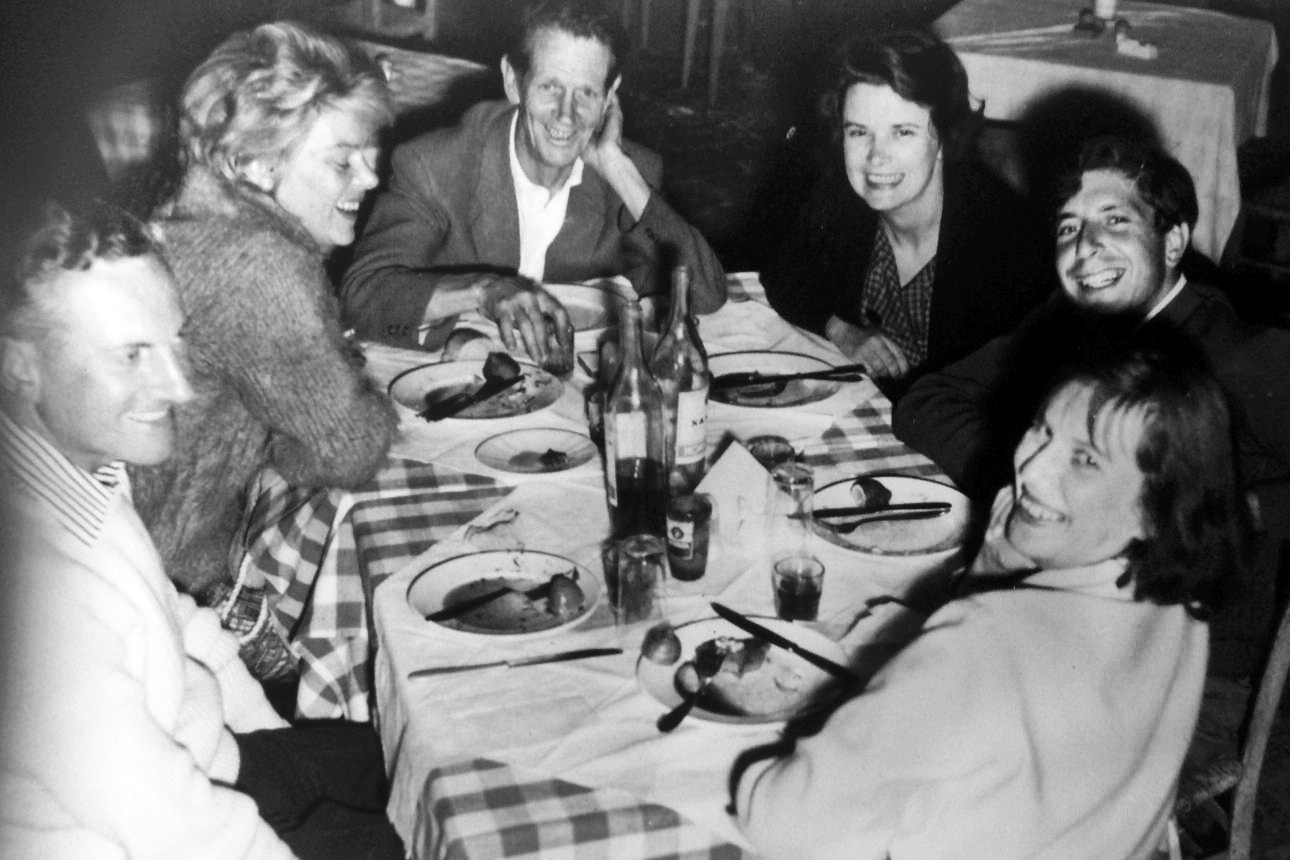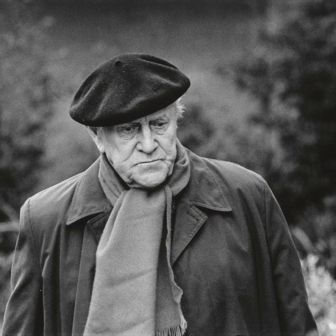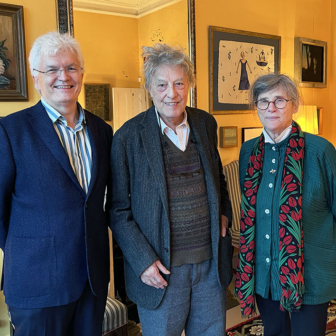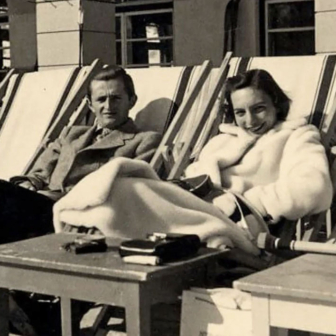Should anyone care whether Charmian Clift and Leonard Cohen had an affair on a Greek island more than sixty years ago? Why, in 2024, might we be concerned if two adults with well-recorded histories of infidelity and casual sex got it together at a time and place when — as a headline in the London Telegraph recently declared — “everyone was shagging everyone”?
After all, the year in question was 1960, and the world was on the cusp of a decade whose radical appeal to “free love” overturned postwar social conservatism. It was a decade to which Clift and Cohen both made liberating contributions, and it might be deemed right that they should have marked its onset with a scene-setting dalliance.
An account of this supposed affair has been aired as part of an eight-part series, So Long Marianne, currently screening on SBS. It was the series’ co-creator, co-writer and director Øystein Karlsen who provided the Telegraph with the “everyone was shagging everyone” line. The Canadian–Norwegian production focuses on the sixties-spanning relationship between Cohen and his muse Marianne Ihlen, which started on the island of Hydra in mid 1960 and was all but exhausted by decade’s end.
The story of that relationship — shifting between Hydra, Oslo, Montreal and New York — is told in parallel with that of Hydra’s older Australian couple, writers Clift and her husband George Johnston. By the time Cohen arrived on the island, Clift and Johnston had been there for five years, revelling in their role at the centre of a proto-hippie community of bohemian expats and visitors. The couple’s own sixties experience would end miserably, with Clift’s suicide in Sydney in 1969 and Johnston’s death the following year.
The first episode of So Long Marianne follows Cohen as he travels from London to Hydra seeking sunshine and a creative spark. He immediately meets Clift who invites him, in true sixties style, to stay in the house she and Johnston share with their three young children. By episode’s end, as Cohen recites “Beneath My Hands,” his early erotic poem of tender love, the two of them have fallen into each other’s arms.
The relationship, conducted in the Clift–Johnston house and with George’s tubercular cough echoing from the floor above, continues into the second episode. After what is described as “six months” they drift apart, Cohen distracted by the alluring and younger Ihlen and Clift acknowledging the liaison as one more in a line of island romances for which she will never forsake George.
While this made-in-bohemian-heaven affair set in a bucolic off-grid paradise, might have been an irresistible cinematic temptation, there is absolutely no evidence that it happened.
Many of the participants and their friends left behind diaries, letters, memoirs and autofiction describing a claustrophobically intimate community where the rumours were hot before the sheets were cold. Even in this febrile environment, no member of the expat circle has even hinted at a sexual relationship between Clift and Cohen. Nor have any of a welter of retrospectively researched and written biographies of Cohen, Clift, Johnston, Ihlen and others associated with the Hydra expats. Despite biographers’ keen eyes for personal entanglements, none has suggested that Clift and Cohen enjoyed anything more than a platonic friendship.
The writers of So Long Marianne call at key points on a book that shares the same title. This is a 2014 biography of Marianne Ihlen on which Ihlen herself collaborated with Norwegian author Kari Hesthamar. That account makes clear that Ihlen and Clift enjoyed a close friendship both before and after Cohen arrived on Hydra. Given that Ihlen was fully aware of Clift’s and Cohen’s sexual adventurism — a trait she herself shared — there is no plausible reason for her to be coy about revealing such a relationship between two people with whom she was intimately associated. But she doesn’t.
In the absence of any evidence that such an affair took place, it is only reasonable to conclude that it didn’t. Which brings us back to the question of whether we should care? Well “we’” (the authors of this article) do care, as we have taken time over a number of years to learn as much as possible about the lives of the Hydra expats. It’s important to us that the stories we share on the subject are accurate and verifiable. We also assume that those who read what we (and others) have written on the subject also care for accuracy.
But should casual consumers of a series like So Long Marianne care too? Life-writing — in numerous forms and in various mediums — has become a dominant form of information and entertainment. Creators and audiences are sufficiently sophisticated to agree that the representation of complex lives often requires manipulation of the literal truth. Many of these manipulations — modified timeframes, condensed locations and incidents, resequenced events, conflated characters, fabricated dialogue — are anticipated and accepted. As well as being justified by the need for concision, these devices enable a narrative to look beyond the skin of representative individuals and examine how they connect to wider narratives of time and place. So it is no surprise to see them on display in So Long Marianne. Ihlen is depicted as pregnant when she and Cohen first encounter each other, for example, whereas the child had been born three months prior to the earliest date at which they could have met.
When film-makers elect to use these imaginative narrative devices it only sharpens the need for a careful approach to the ethical issues that arise in representing a life. In her recent book Artful Truths, philosopher Helena de Bras provides a thorough and lucid account of the many ethical challenges faced when writing memoir — challenges that can be comfortably extrapolated to other forms of life-writing. While de Bras takes a liberal view of what departures from the literal truth are ethically permissible in order to produce art, she draws a line at the “lie,” for which she provides a straightforward definition: “a statement believed to be false with the intention of getting another to believe it to be true.” There can be little doubt that in a series following the basic facts of a widely recounted “true story” and featuring characters identified as Charmian Clift and Leonard Cohen, viewers will assume their sexual relationship to be “true.”
The ethical problems resulting from lies are considerable and frequently harmful, and the more personal a lie the greater the potential for harm. Clearly, few aspects of a life are more personal than sexually intimate relationships and the conditions under which they are conducted. Film-makers are wading into ethical quicksand when they invent intimate relationships between “real” characters.
If similar unproven claims were made about living characters they would provide grounds for legal action. But even if the nature and manner of a “lie” fails to meet the tests required for legal redress, it remains ethically unjustifiable because (as de Bras also points out) the ethical obligations owed to life-writing subjects are considerably more demanding than the standards required by law.
Our concern here is with Clift in particular. Since her death there has been a struggle to exhume her reputation as one of Australia’s finest literary stylists of the twentieth century from beneath the lasting attention given to two biographical details: her oft-cited affairs on Hydra and her suicide.
They are not unconnected. It is often suggested that a provocation that led Clift to take her own life was the imminent publication of Johnston’s autobiographical novel Clean Straw for Nothing. Clift was aware this book about their expatriate years would reveal her infidelities at a time when she had spent five years rebuilding her reputation in Australia with a groundbreaking weekly column for the Sydney Morning Herald and the Melbourne Herald.
Six decades later, when Clift’s true affairs have lost the capacity to shock or directly damage her, she will again face scrutiny because of infidelity. Ironically, this time it will be for an affair that didn’t happen, exacerbated by the fact that it purportedly involved a man who became one of the most widely known public figures of his generation. It is indicative that the London Telegraph article also reported that So Long Marianne describes how “Cohen was taken under the wing and into the bed of Clift,” thereby repeating the gratuitous and even cynical invention. The lie will go on being repeated, deflecting attention from what was most important to Clift — her achievements as a writer.
So yes, we should care about the misleading portrayal of Clift and Cohen’s relationship in So Long Marianne, not just for Clift’s and Cohen’s sake, but also for the sake of audience members concerned with ethically responsible life writing. •
• Charmian Clift: Life Burns High, a documentary account of Clift’s life, is screening on Binge.




